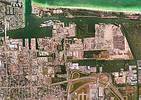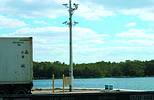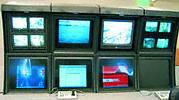

Almost 6000 ships call at Port Everglades annually, and its growing containerised cargo business places it 12th among the US's seaports. The port's petroleum storage and distribution hub serves all of South Florida, it is one of the top three cruise ports in the world, and it boasts a major convention centre within its 800 hectares. Port Everglades itself is one of South Florida's strongest economic engines, and a major security incident or act of terrorism would have strong negative impact on the port and South Florida as well as reverberations throughout the world.

The challenge
Few sites pose more complex or more critical challenges than a country's seaports. In addition to the usual concerns of asset and employee protection, ports face additional security threats from terrorism, drugs and other smuggling operations, and stowaways. Mel Becena, Port Everglades Security Administrator, describes it this way, "Seaports have to allow public traffic on the waterside; we are not a naval base where we can seal off access. There is no way we can ever shut off access, it would impact millions of dollars of commerce."
Becena's Port Everglades security operation is directly in charge of the port's four access gates where thousands of vehicles pass daily, the land perimeter, and the critical waterside. The initial design for the port's Homeland Security system upgrade called for 14 'node rooms' spread out over 800 hectares, in which DVRs and other equipment would connect directly to nearby cameras before the data was put on the network. This design meant expensive hardware would be scattered all over the complex, no centralised control and recording, time-consuming and complicated maintenance, and worst of all, the system design was unnecessarily costly.

The solution
The installation system integrator recommended that the port utilise the unique architecture of a software-based solution to extend and improve on the initial design plan, and recommended a solution by DVTel. The DVTel network video management system (NVMS) enables the port to take advantage of its dedicated one gigabyte network to bring all data back to the security operations centre (SOC). Camera data now travels into DVTel encoders in the node rooms and is then transmitted over the network to the SOC to an ObjectVideo VEW system for intelligent video analysis and to the DVTel NVMS for monitoring and recording.
A key factor in the success of this project is the collaboration and integration between DVTel and ObjectVideo. Becena likes what he sees. "DVTel is a true network-based system, so there was no need to put DVRs all around the port. DVTel's integration with ObjectVideo gives us the performance we need to meet our complex security threats all at a significant savings over the original design."
Not only did the port save substantial money, the DVTel solution is significantly more manageable and scalable than what had first been planned.

The highlights
* Upon completion of the project's first phase, the system comprised more than 200 fixed and PTZ cameras, monitoring port entry and exit points and providing surveillance of the port perimeter, as well as waterside activities. The NVMS' flexibility and scalability will easily accommodate future plans to expand coverage areas with 200 or more new cameras.
* The key to improved design and functionality is the system's ease of integration. The NVMS integrates seamlessly with the Alarm Monitoring System. All three systems - DVTel, ObjectVideo and the alarm system can create alarms that will pop video in the Security Operations Center for immediate and thorough investigation.
* The bulk of system hardware is located in the centralised SOC, allowing for greater control, easier maintenance, and lower TOC (total ownership costs).
* All existing and future cameras are on the port's one-gigabyte network, so the system's Virtual Matrix technology can enable security personnel to call up any camera on any monitor at any time, using a mouse or standard joystick.
* A highly powerful aspect to the port's security is the VEW system deployed on over 100 analog cameras covering the waterside perimeter. Each camera runs all objects in a camera's view against threat-specific pre-programmed rules. When an object violates a rule, for example, a small boat loiters next to a ship or a bag is left unattended at a cruise ship terminal, the software pops video in the SOC through integration with the NVMS and also alerts port security personnel by phone, pager, or e-mail.
* The integration between DVTel and ObjectVideo enables the VEW system to take video data directly from the network instead of from the analog camera. It provides an additional major benefit: any camera can be run through the analysis system, not just the 100 cameras initially dedicated to such intelligent analysis.
* All video is recorded 24 hours seven days a week at seven frames per second to the 33-terabyte Raid Storage Servers. In the event of an alarm, video recording goes immediately to 30 fps (NTSC) to ensure maximum investigation capabilities, while keeping storage demands manageable.

The bottom line
The NVMS software-based architecture implemented at Port Everglades gives the port authorities the freedom to locate equipment where they need it and the freedom to integrate systems together to create the performance and efficiencies that are essential for improved security capabilities at the country's ports. Becena and his team now have eyes all over the port. They can sit in a central location and efficiently monitor and intelligently respond to threats from anywhere in the port complex.

Fact File
Vendor: Niall Beazley, Vision Catcher, SA distributor of DVTel and ObjectVide, 011 463 9797.

© Technews Publishing (Pty) Ltd. | All Rights Reserved.